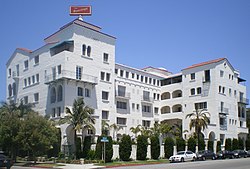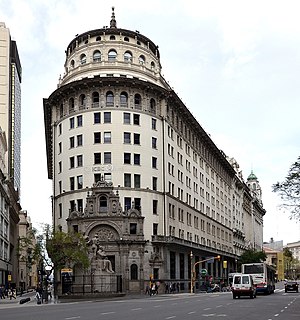
The Spanish Colonial Revival Style is an architectural stylistic movement arising in the early 20th century based on the Spanish Colonial architecture of the Spanish colonization of the Americas.

Mary Elizabeth Jane Colter was an American architect and designer. She was one of the very few female American architects in her day. She was the designer of many landmark buildings and spaces for the Fred Harvey Company and the Santa Fe Railroad, notably in Grand Canyon National Park. Her work had enormous influence as she helped to create a style, blending Spanish Colonial Revival and Mission Revival architecture with Native American motifs and Rustic elements, that became popular throughout the Southwest. Colter was a perfectionist, who spent a lifetime advocating and defending her aesthetic vision in a largely male-dominated field.

The Sarasota Times Building is a historic site in Sarasota, Florida. It is located at 1214–1216 1st Street. On March 22, 1984, it was added to the U.S. National Register of Historic Places. The three-story asymmetrically-massed, stucco and cast stone façade, Mediterranean Revival structure was designed by architect Dwight James Baum. It is significant to Sarasota's heritage for its role as a newspaper established in 1899, and also for its architectural merits.
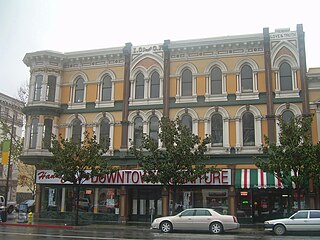
The Downtown Historic District of San Jose, California is a designated U.S. Historic District area of the city roughly the size of one square block. It is bounded by S. First Street to the west, E. San Fernando Street to the south, S. Third Street to the east, and E. Santa Clara Street to the north, but also includes the south side of E. Santa Clara Street between Third and Fourth Streets.

The buildings and architecture of New Orleans are reflective of its history and multicultural heritage, from Creole cottages to historic mansions on St. Charles Avenue, from the balconies of the French Quarter to an Egyptian Revival U.S. Customs building and a rare example of a Moorish revival church.

Charmont Apartments is an historic five-story apartment building in Santa Monica, California which was built in 1928. Designed by architect Max Maltzman with elements of both the Mission Revival-Spanish Colonial Revival style and the Art Deco style, the Charmont was a luxurious high-rise when it was built. The blending of Spanish Colonial Revival and Art Deco elements was popular style in the 1920s and is sometimes known as "Med-Deco." The main entrance is located in a walled courtyard that features a two-tiered fountain with an intricate Moorish-patterned backsplash in polychrome tile.

Granada Shoppes and Studios, also known as the Granada Buildings, is an imaginative, Mediterranean Revival and Spanish Colonial Revival style block-long complex consisting of four courtyard-connected structures, in Central Los Angeles, California. It was built immediately to the southeast of Lafayette Park in the Westlake District, in 1927.
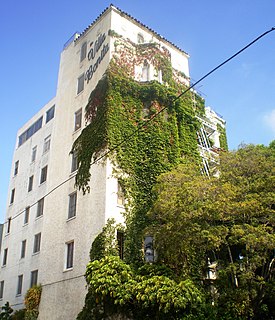
Villa Bonita is an historic apartment building on Hillcrest Road in Hollywood, California. The building is located a short walk from the corner of Hollywood Boulevard and Highland Avenue, just north of Franklin Avenue and west of Highland. It was added to the National Register of Historic Places in 1986 based on its architecture.

The Hollywood Melrose Hotel, also known previously as the Melrose Arms and later as the Monte Cristo Island Apartments, is a historic building on Melrose Avenue in Hollywood, California. Designed by S. Charles Lee, the structure was built in 1927. It has been used both as a hotel and apartments over the years of its existence, with commercial establishments on the first floor. In 1992, the building was listed on the National Register of Historic Places based on its architecture. In April 2010, the hotel was reopened as the newly restored Hollywood Historic Hotel. Edmon Simonian and his family own the property, and operate a furniture gallery located on the hotel's street level. All of the hotel's facades, common spaces, staircases and 62 rooms were restored to their former 1920s glory following an 18-month interior and exterior renovation. By 2021, the hotel had been stripped of many of its restored components. The lobby no longer includes a fireplace, the walls have been repainted cream, and all the bathrooms have been remodeled with new, more generic tubs, sinks, and mirrors.
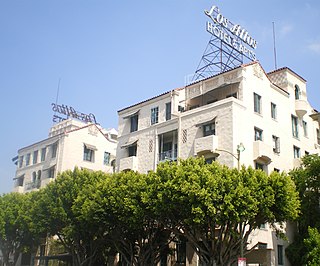
The Los Altos Apartments is a Mission Revival-style apartment building on Wilshire Boulevard in Los Angeles, California.

The Santa Fe Apartments were an apartment building located in Detroit, Michigan. The building was listed on the National Register of Historic Places in 1986 and subsequently demolished by Wayne State University and removed from the National Register of Historic Places in 2022. The site is now the location of the Yousif B. Ghafari Hall.

The Azalea Court Apartments is a historic three-story apartment building located in Mobile, Alabama. It was built in 1928 and was designed by architect J. Platt Roberts in the Spanish Colonial Revival style. It was added to the National Register of Historic Places on February 11, 1988.
Preston J. Bradshaw (1884–1952) was one of the most eminent architects of St. Louis, Missouri, during the 1920s. Among his numerous commissions as an architect, he is best known for designing hotels and automobile dealerships in the region. Like many hotel architects of his time, he eventually moved into the actual operation of hotels, becoming owner and operator of the Coronado Hotel in St. Louis.

The Mission Revival style was part of an architectural movement, beginning in the late 19th century, for the revival and reinterpretation of American colonial styles. Mission Revival drew inspiration from the late 18th and early 19th century Spanish missions in California. It is sometimes termed California Mission Revival, particularly when used elsewhere, such as in New Mexico and Texas which have their own unique regional architectural styles. In Australia, the style is known as Spanish Mission.

The Hotel Virginia was built in 1925. It was listed on the National Register of Historic Places in 2000. It is also designated by the city of Santa Barbara as a local historical landmark. The building is located on the southern side of West Haley Street, 17 W. Haley Street, in the southeastern part of the historical center of Santa Barbara, California.
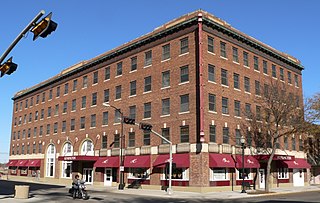
The Hotel Norfolk, at 108 N. Fourth St. in Norfolk, Nebraska, was completed in 1926. It includes Colonial Revival and Georgian Revival architecture. It has also been known as Madison Apartments and as the Kensington Building. It was listed on the National Register of Historic Places in 1988.

The architecture of Jacksonville is a combination of historic and modern styles reflecting the city's early position as a regional center of business. According to the National Trust for Historic Preservation, there are more buildings built before 1967 in Jacksonville than any other city in Florida, but it is also important to note that few structures in the city center predate the Great Fire of 1901. Numerous buildings in the city have held state height records, dating as far back as 1902, and last holding a record in 1981.
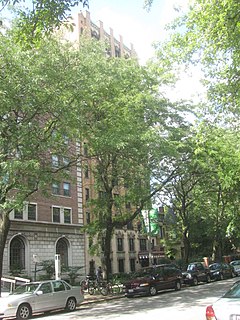
The Poinsettia Apartments are an apartment hotel at 5528 S. Hyde Park Boulevard in the Hyde Park neighborhood of Chicago, Illinois. Built in 1929, the building was the last of several apartment hotels built in Hyde Park during a period of residential development in the late 1910s and 1920s. Apartment hotels were popular among wealthier workers in the city at the time, as they combined the amenities and prestige of hotels with the affordability of apartments. The Poinsettia Apartments were both the smallest of the Hyde Park apartment hotels and the only building designed in the Spanish Colonial Revival style. Its design features pilasters spanning the height of the building, terra cotta ornamentation, and decorative window surrounds on the first two floors.

Historic Hotels of America is a program of the National Trust for Historic Preservation that was founded in 1989 with 32 charter members; the program accepts nominations and identifies hotels that have maintained their authenticity, sense of place, and architectural integrity. In 2015, the program included over 260 members in 44 states, including the District of Columbia, Puerto Rico, and the U.S. Virgin Islands. In 2022, the program includes 273 hotels.
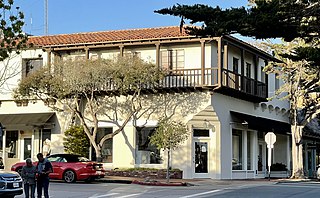
The Goold Building is a historic two-story concrete commercial building in downtown Carmel-by-the-Sea, California. The building is an example of Spanish Colonial Revival and Monterey Colonial styles. The building qualified as an important commercial building in the city's downtown historic district property survey and was registered with the California Register of Historical Resources on February 3, 2003. The building has occupied the Coach Outlet since the 1990s.
